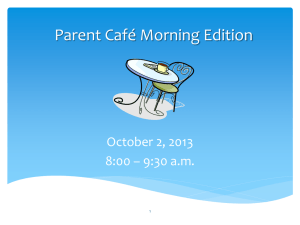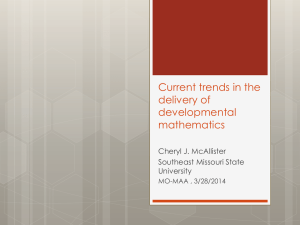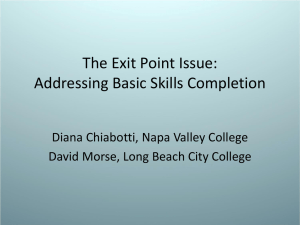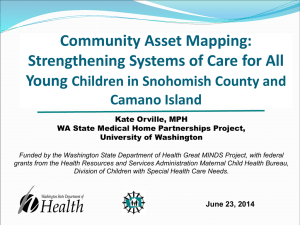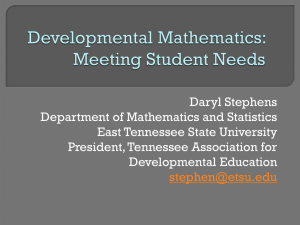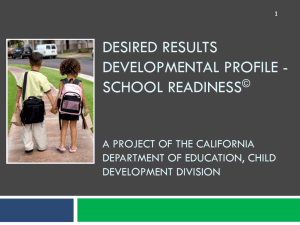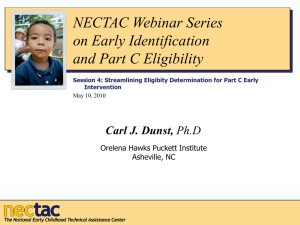Eligibility of a Child with Developmental Delay
advertisement
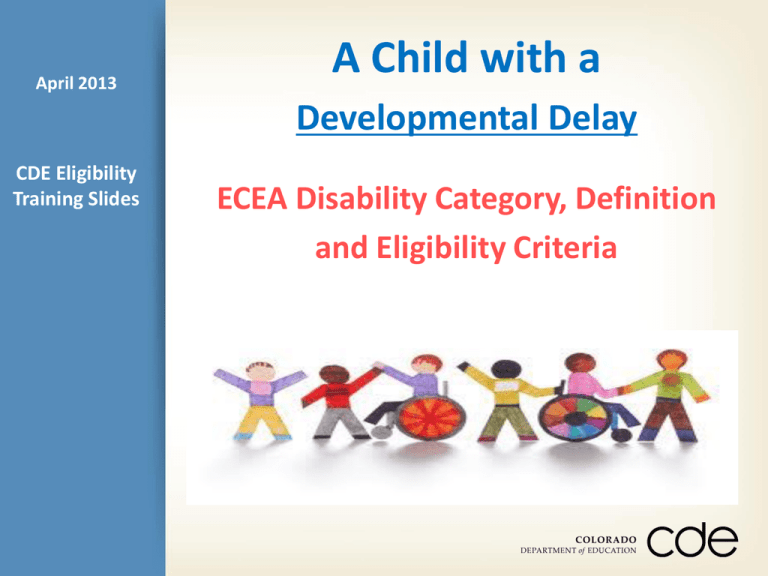
April 2013 A Child with a Developmental Delay CDE Eligibility Training Slides ECEA Disability Category, Definition and Eligibility Criteria Together We Can Vision All students in Colorado will become educated and productive citizens capable of succeeding in a globally competitive workforce. Mission The mission of CDE is to shape, support, and safeguard a statewide education system that prepares all students for success in a globally competitive world. 2 Developmental Delay The following slides have been vetted internally within the Colorado Department of Education for training purposes of the definition and eligibility criteria for Developmental Delay. If you make any changes to these slides, please acknowledge that they are different from this vetted product and may no longer represent the viewpoint of the CDE. 3 Eligibility Checklist for Developmental Delay It is recommended that the following training slides be used in conjunction with the Eligibility Checklist for a Child with a Developmental Delay, which can be found at: http://www.cde.state.co.us/cdesped/IEP_Forms.asp 4 DEVELOPMENTAL DELAY Developmental Delay (formerly Preschooler with a Disability) Penny Dell 5 dell_p@cde.state.co.us (303) 866-6720 2.08 (13) A child with a Developmental Delay shall be three through eight years of age and who is experiencing developmental delays in one or more of the following areas: physical development, cognitive development, communication development, social or emotional development, or adaptive development and as a result is unable to receive reasonable educational benefit from general education and requires special education and related services. 6 2.08(13)(a) For children ages three through eight efforts will be made to identify a child’s primary disability under one of the other Part B eligibility criteria. A child shall be determined to be eligible under the Developmental Delay category only in those situations in which a clear determination cannot be made under any other category as measured by developmentally appropriate diagnostic instruments and procedures. In order for a child to be deemed a child with a Developmental Delay, multiple sources of information must be used to determine if a child meets one or more of the following criteria: 7 2.08(13)(a)(i) A score in the seventh percentile or below on a valid standardized diagnostic instrument, or the technical equivalent in standard scores (77 if the mean is 100 and the standard deviation is 15) or standard deviations (1.5 standard deviations below the mean) in one or more of the following areas of development: physical development, cognitive development, communication development, social or emotional development, or adaptive development as one of the multiple sources of evaluation information; OR 8 2.08(13)(a)(ii) Empirical data showing a condition known to be associated with significant delays in development; OR 2.08(13)(a)(iii) A body of evidence indicating that patterns of learning are significantly different from age expectations across settings and there is written documentation by the evaluation team which includes the parent(s). 9 Why this Change? Reduces inaccurate labeling Eliminates artificial timelines and reduces possible inappropriate practices Increases cost effectiveness Why this Change? Reduces lapses in special education services Clarifies a developmental delay vs. disability Reduces stress on families Aligns with the birth to 8 model What Criteria Must a Child Meet? In order for a child to be determined eligible as a child with a Developmental Delay one OR more of the following criteria must be met: Score in the 7 th Percentile or Below A score in the seventh percentile or below on a valid standardized diagnostic instrument: Using valid and appropriate instruments Used in conjunction with other sources of information Condition Associated with Significant Delays Empirical data showing a condition known to be associated with significant delays in development. Diagnosis of medical conditions known to be associated with development delays (i.e. Down syndrome, cerebral palsy, spina bifida) Consider other eligibility categories (i.e. Orthopedic Impairment, Other Health Impairment, etc.) Body of Evidence – Patterns of Learning are Significantly Different A body of evidence indicating that patterns of learning are significantly different from age expectations across settings and there is written documentation by the evaluation team which includes the parent(s) The body of evidence is gathered through multiple sources and methods of information (i.e. play-based observations, language samples, standardized instruments, developmental checklists, routines- based assessments & family member interviews, parent report, information from Part C providers, etc.) Information gathered from various settings (i.e. classroom, child care, home, etc.) Remember For a young children, delays and/or differences in one area of development can impact other areas of development must be considered. Parental input is especially important for children who have not yet been in a classroom setting. Written documentation must substantiate the presence of a developmental delay. 16 How to Use This Category When a clear determination cannot be made under any other category. Must not be used as a “catch-all” Must use multiple sources of information Must be changed by the Dec 1st Count, if the child will be 9 Expect that very few 8 year olds will be determined eligible under this category Changing From Preschooler With a Disability to Child With a Developmental Delay Most children eligible under Preschooler with a Disability will turn 6 before their triennial Initiate the reevaluation process Provide Prior Written Notice/Obtain Consent for Evaluation Review current information & determine if any other information is needed Complete Child with a Developmental Delay checklist To Be Eligible as a Child With Developmental Delay One of the Following Must be Met: 1. A score in the seventh percentile or below on a valid standardized diagnostic instrument AND/OR 2. Empirical data showing a condition known to be associated with significant delays in development AND/OR 3. A body of evidence indicating that patterns of learning are significantly different from age expectations across settings. AND The condition must create a need for specialized instruction. 19 Thank You! 20



